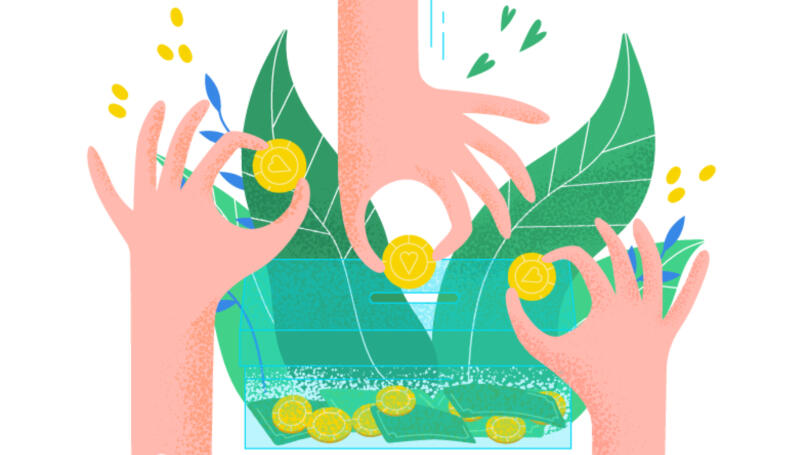Fundraising
What is fundraising?

Fundraising is raising money for an organisation or a project. It's finding different ways to collect the required amount of money. With fundraising you can collect money from governments, private investors, philanthropists, or simply people who care and want to help. Fundraising may have both commercial and non-commercial goals, the latter, however, is more common.
Fundraising is frequently used by NGOs to raise funds for social or cultural projects . Thanks to fundraising, you can not only raise money to help those in need, but also launch a creative or commercial project. This is the major difference between fundraising and charitable activities.
Crowdfunding and fundraising are new tools for financing different projects. So, what's the difference between them? Crowdfunding is collecting donations from as many people as possible: a crowd. While fundraising remains a broader concept that includes various methods of raising money, including crowdfunding.
The definition of fundraising is extremely broad. It includes virtually any way possible to raise money for a project or an organisation. There are various types of fundraising that are very different from each other.
Types of fundraising

A fundraising expert can solve different problems: organise project fundraising or raise money for a company that needs it to continue its operation. For example, through a fundraising campaign, the Metropolitan Museum of Art in New York raised much-needed cash to pay for utility bills and employee wages when the government slashed funding for the museum.
Types of fundraising can be differentiated according to various factors, such as ways to collect money, fundraising sources , or a volume of funds raised . For example, corporate fundraising , where donations are made by large corporations, can raise more funds from a single donor. To receive these kinds of contributions, however, the company needs to have an impeccable reputation.
There are typically two types of fundraising: external and internal. In the first case, a full-time employee looks at different ways to find funding, in the second case - an outside expert is hired. These two distinct categories of fundraising are not very different from each other. If crowdfunding specialists do not make any mistakes, the fundraising process goes through the same stages .
Fundraising stages

Fundraising cycle is steps that will enable you to organise the fundraising process in such a way that you will be more likely to find financing you need. These steps can be used regardless of who and with what purpose is organising a fundraising campaign (a company, an NGO, or a private person.) Fundraising stages include:
- Identifying and describing the problem or task.
- Analysing the target audience: the stakeholders of a company or a project. Identifying the project's target audience is a crucial stage that will determine the success of all fundraising efforts. Therefore, it is important to understand who will be interested in the project and why, in order to know who to contact during the project promotion, and how to interact with those people.
- Setting goals and objectives. They should be specific, realistic, and measurable.
- Analysing the tools that are necessary to solve project tasks and achieve its goals.
- Budgeting. At the budgeting stage , you need to identify the tools which are required to achieve the project goal and which the team lacks, and allocate funds for them in the company's budget.
- Finding and analysing potential donors. At this stage you need to rank the donors: consider donors who are more likely to contribute a larger amount.
- Organising a fundraising event if the organisers have planned one.
- Analysing the results and searching for insights. Monitoring the fundraising process will help you discover any errors and analyse them to stop them from occurring in the future.
- Expressing gratitude to donors. Donors usually donate to a project more than once. To guarantee their contributions in the future, however, it is important to maintain an excellent relationship with your donors, even when the fundraising campaign has come to an end. This is because the foundations for long-term collaboration are laid during the initial fundraising campaign.
To successfully raise the necessary funds, you need to use the best fundraising techniques and fundraising tools .
Fundraising tools

The success of any fundraising campaign depends largely, if not entirely, on the relationship with the target audience. Building a great relationship with them requires that you use new tools and techniques . The Internet allows you to maintain regular contact with your audience, which means you can develop a strong relationship with them.At the same time, thanks to the Internet, you can minimise the costs of fundraising events by moving them online.
When using fundraising in the cultural or charitable sector , it is essential to remember that the project goals must be clear to the audience whilst making it easier for them to donate. For example, in Europe, the number of charitable contributions through the L'Arrondi service has increased, allowing a small percentage of every purchase through a shop to be donated to charity.
In simple terms, fundraising is finding financing for an organisation or a project. Fundraising may have different goals, in most cases, though, the funds are raised for a charity or a creative project. Fundraising features diverse techniques to raise money that involve many different methods and practices. Acquiring a fundraising education will allow you to discover other fundraising opportunities and help you to find the best way to finance your project.























